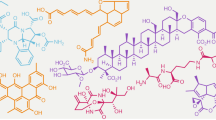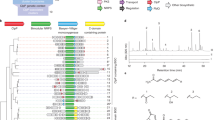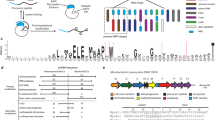Abstract
Cyclic peptide natural products have served as important drug molecules, with several examples used clinically. Enzymatic or chemical macrocyclization is the key transformation for constructing these chemotypes. Methods to generate new and diverse cyclic peptide scaffolds enabling the modular and predictable synthesis of peptide libraries are desirable in drug discovery platforms. Here we identify a suite of post-translational modifying enzymes from bacteria that install single or multiple strained cyclophane macrocycles. The crosslinking occurs on three-residue motifs that include tryptophan or phenylalanine to form indole- or phenyl-bridged cyclophanes. The macrocycles display restricted rotation of the aromatic ring and induce planar chirality in the asymmetric indole bridge. The biosynthetic gene clusters originate from a broad range of bacteria derived from marine, terrestrial and human microbiomes. Three-residue cyclophane-forming enzymes define a new and significant natural product family and occupy a distinct region in sequence–function space.

This is a preview of subscription content, access via your institution
Access options
Access Nature and 54 other Nature Portfolio journals
Get Nature+, our best-value online-access subscription
$29.99 / 30 days
cancel any time
Subscribe to this journal
Receive 12 print issues and online access
$259.00 per year
only $21.58 per issue
Buy this article
- Purchase on Springer Link
- Instant access to full article PDF
Prices may be subject to local taxes which are calculated during checkout







Similar content being viewed by others
Data availability
The data analysed and used to support this study can be found within the main text, supporting information or from the corresponding author upon reasonable request.
References
White, C. J. & Yudin, A. K. Contemporary strategies for peptide macrocyclization. Nat. Chem. 3, 509–524 (2011).
Vinogradov, A. A., Yin, Y. & Suga, H. Macrocyclic peptides as drug candidates: recent progress and remaining challenges. J. Am. Chem. Soc. 141, 4167–4181 (2019).
Arnison, P. G. et al. Ribosomally synthesized and post-translationally modified peptide natural products: overview and recommendations for a universal nomenclature. Nat. Prod. Rep. 30, 108–160 (2013).
Repka, L. M., Chekan, J. R., Nair, S. K. & van der Donk, W. A. Mechanistic understanding of lanthipeptide biosynthetic enzymes. Chem. Rev. 117, 5457–5520 (2017).
Flühe, L. & Marahiel, M. A. Radical S-adenosylmethionine enzyme catalyzed thioether bond formation in sactipeptide biosynthesis. Curr. Opin. Chem. Biol. 17, 605–612 (2013).
Hudson, G. A. et al. Bioinformatic mapping of radical S-adenosylmethionine-dependent ribosomally synthesized and post-translationally modified peptides identifies new Cα, Cβ, and Cγ-linked thioether-containing peptides. J. Am. Chem. Soc. 141, 8228–8238 (2019).
Ramalho, S. D., Pinto, M. E. F., Ferreira, D. & Bolzani, V. S. Biologically active orbitides from the Euphorbiaceae family. Planta Med. 84, 558–567 (2018).
Craik, D. J., Daly, N. L., Bond, T. & Waine, C. Plant cyclotides: a unique family of cyclic and knotted proteins that defines the cyclic cystine knot structural motif. J. Mol. Biol. 294, 1327–1336 (1999).
Gu, W., Dong, S.-H., Sarkar, S., Nair, S. K. & Schmidt, E. W. The biochemistry and structural biology of cyanobactin pathways: enabling combinatorial biosynthesis. Methods Enzymol. 604, 113–163 (2018).
Bagley, M. C., Dale, J. W., Merritt, E. A. & Xiong, X. Thiopeptide antibiotics. Chem. Rev. 105, 685–714 (2005).
Zheng, Q., Fang, H. & Liu, W. Post-translational modifications involved in the biosynthesis of thiopeptide antibiotics. Org. Biomol. Chem. 15, 3376–3390 (2017).
Craik, D. J., Fairlie, D. P., Liras, S. & Price, D. The future of peptide-based drugs. Chem. Biol. Drug Des. 81, 136–147 (2013).
Zorzi, A., Deyle, K. & Heinis, C. Cyclic peptide therapeutics: past, present and future. Curr. Opin. Chem. Biol. 38, 24–29 (2017).
Umemura, M. et al. MIDDAS-M: motif-independent de novo detection of secondary metabolite gene clusters through the integration of genome sequencing and transcriptome data. PLoS ONE 8, e84028 (2013).
Umemura, M. et al. Characterization of the biosynthetic gene cluster for the ribosomally synthesized cyclic peptide ustiloxin B in Aspergillus flavus. Fungal Genet. Biol. 68, 23–30 (2014).
Ye, Y. et al. Unveiling the biosynthetic pathway of the ribosomally synthesized and post-translationally modified peptide ustiloxin b in filamentous fungi. Angew. Chem. Int. Ed. 55, 8072–8075 (2016).
Ding, W. et al. Biosynthetic investigation of phomopsins reveals a widespread pathway for ribosomal natural products in Ascomycetes. Proc. Natl Acad. Sci.USA 113, 3521–3526 (2016).
Nagano, N. et al. Class of cyclic ribosomal peptide synthetic genes in filamentous fungi. Fungal Genet. Biol. 86, 58–70 (2016).
Ye, Y. et al. Heterologous production of asperipin-2a: proposal for sequential oxidative macrocyclization by a fungi-specific DUF3328 oxidase. Org. Biomol. Chem. 17, 39–43 (2019).
Tan, N.-H. & Zhou, J. Plant cyclopeptides. Chem. Rev. 106, 840–895 (2006).
Han, B. H., Park, M. H. & Han, Y. N. Cyclic peptide and peptide alkaloids from seeds of Zizyphus vulgaris. Phytochemistry 29, 3315–3319 (1990).
Pandey, M. B., Singh, A. K., Singh, J. P., Singh, V. P. & Pandey, V. B. Three new cyclopeptide alkaloids from Zizyphus species. J. Asian Nat. Prod. Res. 10, 709–713 (2008).
Yoshikawa, K., Tao, S. & Arihara, S. Stephanotic acid, a novel cyclic pentapeptide from the stern of Stephanotis floribunda. J. Nat. Prod. 63, 540–542 (2000).
Broderick, J. B., Duffus, B. R., Duschene, K. S. & Shepard, E. M. Radical S-adenosylmethionine enzymes. Chem. Rev. 114, 4229–4317 (2014).
Schramma, K. R., Bushin, L. B. & Seyedsayamdost, M. R. Structure and biosynthesis of a macrocyclic peptide containing an unprecedented lysine-to-tryptophan crosslink. Nat. Chem. 7, 431–437 (2015).
Bushin, L. B., Clark, K. A., Pelczer, I. & Seyedsayamdost, M. R. Charting an unexplored streptococcal biosynthetic landscape reveals a unique peptide cyclization motif. J. Am. Chem. Soc. 140, 17674–17684 (2018).
Caruso, A., Martinie, R. J., Bushin, L. B. & Seyedsayamdost, M. R. Macrocyclization via an arginine–tyrosine crosslink broadens the reaction scope of radical S-adenosylmethionine enzymes. J. Am. Chem. Soc. 141, 16610–16614 (2019).
Barr, I. et al. Demonstration that the radical S-adenosylmethionine (SAM) enzyme PqqE catalyzes de novo carbon–carbon cross-linking within a peptide substrate PqqA in the presence of the peptide chaperone PqqD. J. Biol. Chem. 291, 8877–8884 (2016).
Zhu, W., Martins, A. M. & Klinman, J. P. Methods for expression, purification, and characterization of PqqE, a radical SAM enzyme in the PQQ biosynthetic pathway. Methods Enzymol. 606, 389–420 (2018).
Forneris, C. C. & Seyedsayamdost, M. R. In vitro reconstitution of OxyC activity enables total chemo-enzymatic syntheses of vancomycin aglycone variants. Angew. Chem. Int. Ed. 57, 8048–8052 (2018).
Ozturk, S., Forneris, C. C., Nguy, A. K. L., Sorensen, E. J. & Seyedsayamdost, M. R. Modulating OxyB-catalyzed cross-coupling reactions in vancomycin biosynthesis by incorporation of diverse d-Tyr analogues. J. Org. Chem. 83, 7309–7317 (2018).
Greule, A. et al. Kistamicin biosynthesis reveals the biosynthetic requirements for production of highly crosslinked glycopeptide antibiotics. Nat. Commun. 10, 2613 (2019).
Mahanta, N., Hudson, G. A. & Mitchell, D. A. Radical S-adenosylmethionine enzymes involved in RiPP biosynthesis. Biochemistry 56, 5229–5244 (2017).
Morinaka, B. I. et al. Radical S-adenosyl methionine epimerases: regioselective introduction of diverse d-amino acid patterns into peptide natural products. Angew. Chem. Int. Ed 53, 8503–8507 (2014).
Morinaka, B. I., Verest, M., Freeman, M. F., Gugger, M. & Piel, J. An orthogonal D2O-based induction system that provides insights into d-amino acid pattern formation by radical S-adenosylmethionine peptide epimerases. Angew. Chem. Int. Ed. 56, 762–766 (2017).
Freeman, M. F. et al. Metagenome mining reveals polytheonamides as posttranslationally modified ribosomal peptides. Science 338, 387–390 (2012).
Haft, D. H., Basu, M. K. & Mitchell, D. A. Expansion of ribosomally produced natural products: a nitrile hydratase- and Nif11-related precursor family. BMC Biology 8, 70 (2010).
Morinaka, B. I. et al. Natural noncanonical protein splicing yields products with diverse β-amino acid residues. Science 359, 779–782 (2018).
Grell, T. A. J., Goldman, P. J. & Drennan, C. L. SPASM and Twitch domains in S-adenosylmethionine (SAM) radical enzymes. J. Biol. Chem. 290, 3964–3971 (2015).
Haft, D. H. & Basu, M. K. Biological systems discovery in silico: radical S-adenosylmethionine protein families and their target peptides for posttranslational modification. J. Bacteriol. 193, 2745–2755 (2011).
Haft, D. H., Selengut, J. D. & White, O. The TIGRFAMs database of protein families. Nucleic Acids Res. 31, 371–373 (2003).
Oman, T. J. & van der Donk, W. A. Follow the leader: the use of leader peptides to guide natural product biosynthesis. Nat. Chem. Biol. 6, 9–18 (2010).
Gulder, T. & Baran, P. S. Strained cyclophane natural products: macrocyclization at its limits. Nat. Prod. Rep. 29, 899–934 (2012).
Gerlt, J. A. Genomic enzymology: web tools for leveraging protein family sequence-function space and genome context to discover novel functions. Biochemistry 56, 4293–4308 (2017).
Copp, J. N., Akiva, E., Babbitt, P. C. & Tokuriki, N. Revealing unexplored sequence-function space using sequence similarity networks. Biochemistry 57, 4651–4662 (2018).
Mitchell, A. L. et al. InterPro in 2019: improving coverage, classification and access to protein sequence annotations. Nucleic Acids Res. 47, D351–D360 (2019).
Shannon, P. et al. Cytoscape: a software environment for integrated models of biomolecular interaction networks. Genome Res. 13, 2498–2504 (2003).
Hooper, N. M. Families of zinc metalloproteases. FEBS Lett. 354, 1–6 (1994).
Marfey, P. Determination of d-amino acids. II. Use of a bifunctional reagent, 1,5-difluoro-2,4-dinitrobenzene. Carlsberg Res. Commun. 49, 591–596 (1984).
Lei, M. et al. Discovery of a novel dipeptidyl boronic acid proteasome inhibitor for the treatment of multiple myeloma and triple-negative breast cancer. Org. Biomol. Chem. 17, 683–691 (2019).
Forbes, C. R., Pandey, A. K., Ganguly, H. K., Yap, G. P. A. & Zondlo, N. J. 4R- and 4S-iodophenyl hydroxyproline, 4R-pentynoyl hydroxyproline, and S-propargyl-4-thiolphenylalanine: conformationally biased and tunable amino acids for bioorthogonal reactions. Org. Biomol. Chem. 14, 2327–2346 (2016).
Chen, K., Zhang, S.-Q., Xu, J.-W., Hu, F. & Shi, B.-F. A general and practical palladium-catalyzed monoarylation of β-methyl C(sp3)–H of alanine. Chem. Commun. 50, 13924–13927 (2014).
Tran, L. D. & Daugulis, O. Nonnatural amino acid synthesis by using carbon–hydrogen bond functionalization methodology. Angew. Chem. Int. Ed. 51, 5188–5191 (2012).
Reddy, B. V. S., Reddy, L. R. & Corey, E. J. Novel acetoxylation and C–C coupling reactions at unactivated positions in α-amino acid derivatives. Org. Lett. 8, 3391–3394 (2006).
Bode, E. et al. Simple ‘on-demand’ production of bioactive natural products. ChemBioChem 16, 1115–1119 (2015).
Zallot, R., Oberg, N. O. & Gerlt, J. A. ‘Democratized’ genomic enzymology web tools for functional assignment. Curr. Opin. Chem. Biol. 47, 77–85 (2018).
Forst, S., Dowds, B., Boemare, N. & Stackebrandt, E. Xenorhabdus and Photorhabdus spp.: bugs that kill bugs. Annu. Rev. Microbiol. 51, 47–72 (1997).
Wren, B. W. The Yersiniae—a model genus to study the rapid evolution of bacterial pathogens. Nat. Rev. Microbiol. 1, 55–64 (2003).
Scott, T. A. & Piel, J. The hidden enzymology of bacterial natural product biosynthesis. Nat. Rev. Chem. 3, 404–425 (2019).
Imai, Y. et al. A new antibiotic selectively kills Gram-negative pathogens. Nature 576, 459–464 (2019).
Rice, J. E. et al. [5]Paracyclophane. An important example of ring strain and aromaticity in hydrocarbon compounds. J. Am. Chem. Soc. 109, 2902–2909 (1987).
Wang, W., Lorion, M. M., Shah, J., Kapdi, A. R. & Ackermann, L. Late-stage peptide diversification by position-selective C–H activation. Angew. Chem. Int. Ed. 57, 14700–14717 (2018).
Zhang, X. et al. A general strategy for synthesis of cyclophane-braced peptide macrocycles via palladium-catalysed intramolecular sp3 C-H arylation. Nat. Chem. 10, 540–548 (2018).
Flühe, L. et al. Two [4Fe–4S] clusters containing radical SAM enzyme SkfB catalyze thioether bond formation during the maturation of the sporulation killing factor. J. Am. Chem. Soc. 135, 959–962 (2013).
Nakai, T. et al. The radical S-Adenosyl-l-methionine enzyme QhpD catalyzes sequential formation of intra-protein sulfur-to-methylene carbon thioether bonds. J. Biol. Chem. 290, 11144–11166 (2015).
Grove, T. L. et al. Structural insights into thioether bond formation in the biosynthesis of sactipeptides. J. Am. Chem. Soc. 139, 11734–11744 (2017).
Bruender, N. A., Wilcoxen, J., Britt, R. D. & Bandarian, V. Biochemical and spectroscopic characterization of a radical S-adenosyl-l-methionine enzyme involved in the formation of a peptide thioether cross-link. Biochemistry 55, 2122–2134 (2016).
Bruender, N. A. & Bandarian, V. The radical S-adenosyl-l-methionine enzyme MftC catalyzes an oxidative decarboxylation of the C-terminus of the MftA peptide. Biochemistry 55, 2813–2816 (2016).
Khaliullin, B. et al. Mycofactocin biosynthesis: modification of the peptide MftA by the radical S-adenosylmethionine protein MftC. FEBS Lett. 590, 2538–2548 (2016).
Benjdia, A., Guillot, A., Ruffié, P., Leprince, J. & Berteau, O. Post-translational modification of ribosomally synthesized peptides by a radical SAM epimerase in Bacillus subtilis. Nat. Chem. 9, 698–707 (2017).
Acknowledgements
We thank J. Wu and Y. Han for assistance with NMR experiments, H. Y. Chen and I. Y. F. Koh for assistance in preparation of the MscA variant, C. Kegler and H. B. Bode for the pCEP plasmid and E. coli S17-1λpir donor strain, X. Cai for helpful discussions, E. Danelius and T. Gonen for attempts to elucidate structures by MicroED and J. Piel for critical reading of the manuscript. We acknowledge funding from the Human Frontier Science Program and Japan Society for Promotion of Science to R.S., the Ministry of Education for research scholarships to M.P. and T.P.D.N. and the MOE NUS Start-up Grant (R-148-000-257-133), MOE Tier 1 Grants (R-148-000-258-114 and R-148-000-271-114) and MOE NUS Early Career Research Award (R-148-000-291-133) to B.I.M.
Author information
Authors and Affiliations
Contributions
T.Q.N.N., Y.W.T., R.H.S.Y., M.G. and B.I.M. performed bioinformatics and designed the experiments. T.Q.N.N., Y.W.T., T.P.D.N, M.P., L.C.L., K.H., R.H.S.Y., I.A. and B.I.M. performed coexpression experiments and acquired and analysed LC-MS data. T.Q.N.N., T.P.D.N, F.W., A.T.P. and B.I.M acquired and analysed NMR data. R.S. carried out heterologous expression experiments. T.Q.N.N. carried out promoter exchange experiments. T.Q.N.N and B.I.M carried out degradation and synthesis. T.Q.N.N., Y.W.T. and B.I.M. wrote the manuscript. All authors discussed the results and commented on the manuscript.
Corresponding author
Ethics declarations
Competing interests
The authors T.Q.N.N, Y.W.T and B.I.M. are the inventors on International Patent Application No. PCT/SG2020/050303 submitted by the National University of Singapore, which covers the use of radical S-adenosylmethionine enzymes for introducing cyclophanes into polypeptides.
Additional information
Publisher’s note Springer Nature remains neutral with regard to jurisdictional claims in published maps and institutional affiliations.
Supplementary information
Supplementary Information
Supplementary methods, spectral data, Figs. 1–46 and Tables 1–8 and 12.
Supplementary Table 9, 10, 11
Supplementary Tables 9–11.
Rights and permissions
About this article
Cite this article
Nguyen, T.Q.N., Tooh, Y.W., Sugiyama, R. et al. Post-translational formation of strained cyclophanes in bacteria. Nat. Chem. 12, 1042–1053 (2020). https://doi.org/10.1038/s41557-020-0519-z
Received:
Accepted:
Published:
Issue Date:
DOI: https://doi.org/10.1038/s41557-020-0519-z
This article is cited by
-
Discovery and biosynthesis of cyclic plant peptides via autocatalytic cyclases
Nature Chemical Biology (2022)
-
Radical SAM-dependent ether crosslink in daropeptide biosynthesis
Nature Communications (2022)
-
Bicyclostreptins are radical SAM enzyme-modified peptides with unique cyclization motifs
Nature Chemical Biology (2022)
-
Computational identification of a systemic antibiotic for Gram-negative bacteria
Nature Microbiology (2022)



